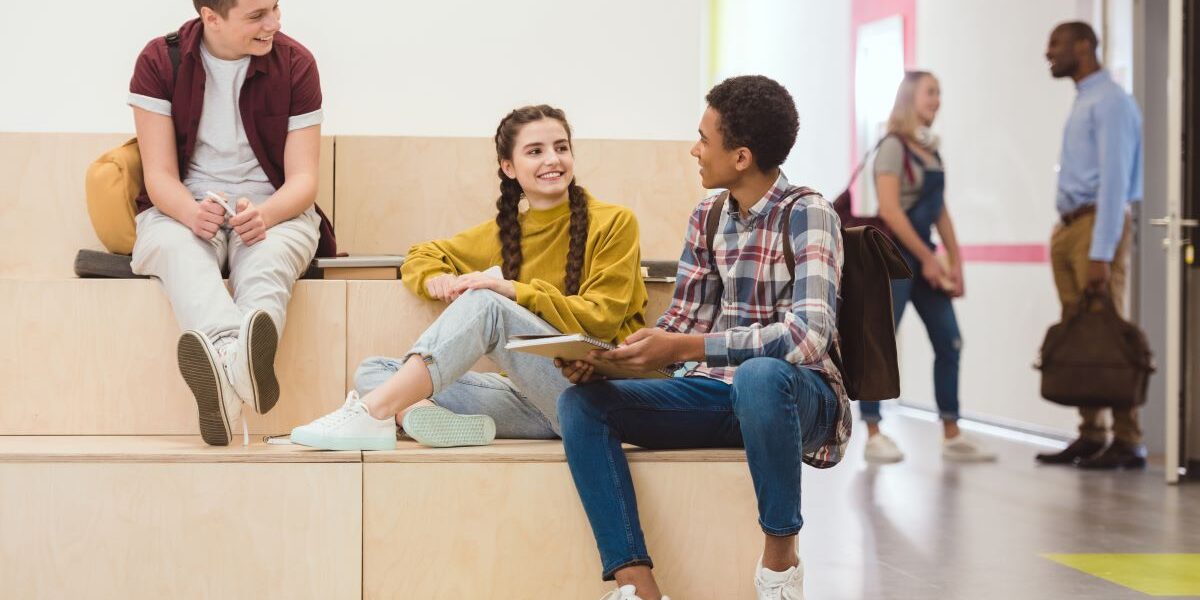Common spaces in 21st century schools are areas that exist in virtually all buildings but have never been utilized for learning.
And, they can be as different as the school buildings they’re in. From hallways to stairwells, what was once dead space is being put to work in innovative new ways.
Often outfitted with lounge seating mobile furniture and tech functionality, common spaces are designed to accommodate learning wherever and whenever the mood strikes.
For instance, at Yorkville High School in Illinois, “Hallways were widened from 16 to 25 feet, adding space for lockers and computer bars and fishbowls, quiet, glass-enclosed rooms where groups of up to six students can focus and work together.”
In this way, the school has taken a place we often give no regard to and turned it into a functional, effective space for impromptu discussions, breakout sessions and social activity.
Where did common spaces come from?
Today’s common spaces are a result of advances in education. In embracing the idea that learning involves more than facts and figures, educators are looking for ways to bring 21st century practices into every aspect of their schools, including unused or under-used physical spaces.
The idea is to make the entire school a space for learning: to encourage collaboration, critical thinking and problem solving wherever students may gather.
As educational concepts like flexible learning and project-based learning take shape in schools, educators are seeing the benefit of a diverse variety of spaces in which learning can take place.
Additionally, putting unused spaces to work makes logistical sense.
The Boston architecture firm Arrowstreet notes that “over 35% of the average school’s square footage is in use less than 5% of the typical school day.”
By putting as much space to use as possible, schools are able to do more with less, thereby cutting down on the need for costly expansions and/or large pieces of real estate.
By outfitting common areas with inviting furnishings, schools are finding more chances for students to immerse themselves in learning.
Common areas can occur in rooms such as media centers and food courts, and also be created to make use of spaces such as hallways, entryways and other open expanses.
These comfortable gathering spots provide opportunities for groups to meet or for individuals to study in a more relaxed atmosphere than they might experience in their usual learning spaces.
Providing these spaces facilitates learning throughout the day in a number of ways:
Continuing Discussions After Class
Informal gathering places can allow classroom discussions and debates to spill into after-class conversations.
Research suggests that students are likely to start these informal talks in comfortable areas located close to the classroom.
Educators can plan for these post-lesson talks by designing shared areas in multiple locations that are near classrooms and other active learning spaces.
Furniture should be inviting, with soft seating arranged so students can immediately bring conversations into the gathering spaces after they exit their classes.
The space also needs to be equipped with outlets and USB ports to charge devices.
Comfortable furniture with handy features creates the conditions for students to reinforce their learning through relaxed discourse.
Scheduling Collaborative Work Outside of Class
Projects started during the learning period often require collaboration outside of the allotted session time.
Shared spaces provide familiar venues where students can plan time to continue their work and form new perspectives that might be gained when considering ideas outside of class.
Feeling relaxed in a comfortable common space can also free students to think more creatively and speak more readily than they might in a more formal learning setting.
Including writing surfaces in group areas allows participants to capture their ideas during these out-of-class sessions.
Impromptu Meetings
Sometimes, the best ideas happen through “happy accidents.” Chance meetings with teachers or between peers can turn into richer discussions when opportune places are available for them to sit and hear each other’s thoughts.
When schools furnish entryways, hallways and other highly trafficked areas with appealing seating options, they set the stage for these incidental conversations to take place.
Individual Focus
Shared spaces can also provide individual nooks where students can read and study on their own in relaxed settings.
For many, these less formal learning spaces allow people to get away from social distractions so they can better focus on their material.
Different students might adopt different postures to help them concentrate. Many like to recline on a sofa or large chair while reading. Others might like to sit in a chair while they spread papers and devices on tabletops to search for insights among their materials.
Common areas can optimize individual work when seating allows students to take a variety of postures.
Collegial Atmosphere
When schools invest in attractive furnishings for their entryways, hallways and dedicated learning areas, they communicate trust in their students’ ability to collaborate and study independently.
These areas also set the expectation that learning should happen in all places within the school. Deliberately designed common areas can spark students’ feelings of collegiality, putting them at the center of their learning experiences.
Being comfortable in collaborative settings and the ability to work well with others are increasingly valuable real-world skills.
By fostering them at every chance they get, schools are setting students up for success in the future.
This information is courtesy of School Outfitters, which helps schools achieve their learning space goals with innovative furniture and equipment, free room design services, and end-to-end project management, www.schooloutfitters.com.














